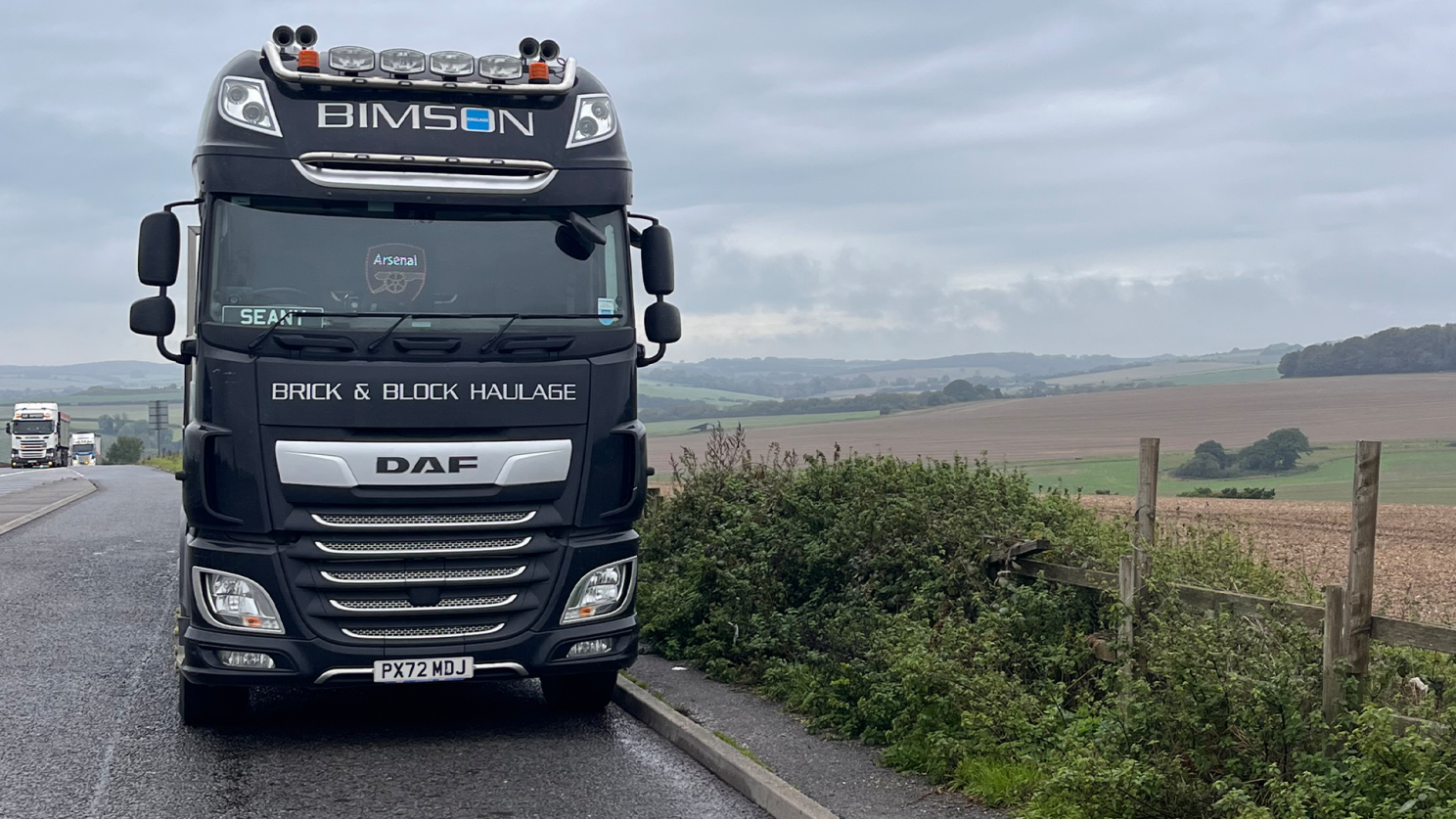
Susie Jones
Contos de camionista: histórias da estrada
Criado: 22/08/2024
•
Atualizado: 22/08/2024
Queremos iluminar a comunidade de camionistas e conhecer as pessoas ao volante.
Desde helicópteros que aterram à frente dos camiões a carros que circulam no lado errado da autoestrada, saiba mais sobre os condutores que entregam as suas mercadorias.
Alan
Alan conduz há 23 anos e decidiu juntar-se à indústria depois de ouvir as canções de condução de camiões de Ally Thomson. Quando lhe perguntam o que mais gosta no seu trabalho, afirma que é "a solidão que a condução de camiões proporciona - há uma separação completa da vida doméstica".
Os camiões Volvo são os seus favoritos, uma vez que viaja pelo Reino Unido transportando mercadorias da Amazon. Ele diz que já transportou muitos produtos interessantes, "a escolha é ilimitada - basta pensar em tudo o que a Amazon vende".
Para os condutores que estacionam durante a noite, é difícil manterem-se entretidos durante o tempo de inatividade. No entanto, condutores experientes como Alan têm uma rotina nocturna perfeita. Ele afirma que "gosta de ver Sky TV através do iPad" quando está estacionado durante a noite.

Para os condutores que se esforçam por se manterem entretidos ao volante, compilámos uma lista de formas de evitar o tédio.
Embora as longas horas na estrada possam parecer monótonas para muitos, Alan explica que há sempre algo que o mantém alerta.
"Acho que a coisa mais louca que já vi enquanto conduzia foi um helicóptero a aterrar mesmo à minha frente", explica - muito longe da reputação monótona que envolveu a indústria durante décadas.
Com 23 anos de experiência neste sector, Alan ofereceu alguns conselhos que manterão os seus brancos perolados com um aspeto fresco durante as suas viagens.
Ele explica: "o conselho que eu daria a qualquer pessoa nova no sector é que se lembre sempre de manter a sua escova de dentes carregada".
Richard
Há 36 anos, Richard iniciou a sua carreira no sector dos transportes e nunca mais olhou para trás. Apanhou o bichinho da condução quando se juntou aos seus dois irmãos mais velhos para ajudar a entregar mercadorias em todo o Reino Unido.
"Adoro pegar numa carga e partir. Posso decidir quando faço uma pausa e onde estaciono. Estar na estrada e viajar por todo o Reino Unido é ótimo", explica.
Durante a sua carreira, a vida na estrada levou-o a Milão, Itália - uma viagem extenuante mesmo para os condutores mais experientes. Quando lhe perguntam como se mantém entretido nas suas viagens, afirma: "Gosto de ouvir música e ver filmes durante o meu tempo de descanso".

O melhor camião para fazer isto? "Tem de ser um Scania Next Generation 450S", diz ele.
Para Richard, 30 anos na indústria não foram isentos da sua quota-parte de histórias loucas e entregas invulgares: "Já vi um carro a ir na direção errada numa autoestrada, a sair de uma estrada de acesso. A coisa mais interessante que já tive na parte de trás do camião foi um carro alegórico da parada do Dia de São Wilfred."
Embora continue a adorar a estrada, Richard afirma que, por vezes, isso tem um preço. Ele oferece uma grande visão da realidade desta profissão e conselhos para aqueles que procuram entrar no sector.
"Pense muito bem se esta é a carreira certa para si. Espere longas horas de trabalho e a perda de muita vida familiar."
Sean
Crescer numa família de condutores significava que o transporte rodoviário estava no sangue de Sean e, há 20 anos, ele pôs-se ao volante e prosseguiu a sua carreira no sector dos transportes.
O trabalho tem muitas vantagens, mas para Sean, a liberdade que o trabalho oferece é o que ele mais gosta. Esta liberdade levou-o até à Escócia para um serviço de seis semanas. Nessas longas viagens, telefonar aos amigos e ver televisão são a sua fonte de entretenimento.

Além disso, as paragens de camiões têm desempenhado um papel fundamental para Sean combater o isolamento que a condução acarreta. Frequentemente um centro de atividade, as paragens de camiões permitem a Sean encontrar-se com amigos durante as suas viagens.
Estas paragens nas boxes são a oportunidade perfeita para ouvir histórias loucas de outros condutores de camiões. À semelhança de Richard, a coisa mais estranha que Sean viu nas suas viagens foi "um carro a ir na direção errada numa autoestrada às escuras" - uma história demasiado comum entre a comunidade de camionistas.
Um DAF XF 530 é o camião de eleição de Sean para o transporte de materiais de construção em todo o Reino Unido. Ele aconselha qualquer pessoa que esteja à procura de uma carreira no sector dos camiões a "ir em frente!"
Dave
Dave conduz camiões há 30 anos e já viajou até à Dinamarca e Espanha. Quando não está a viajar no seu camião favorito, um Volvo FH, gosta de ver novelas no conforto da sua cabina.
"O comportamento de alguns condutores de automóveis deu-me algumas histórias loucas para contar", explica. No entanto, quando perguntámos a Dave qual a coisa mais interessante que já teve na parte de trás do seu camião, ele manteve-se calado - "é ultrassecreto", afirma.
Após 30 anos de transporte de mercadorias, Dave aprendeu algumas coisas sobre o mundo dos transportes. Ele dá um grande conselho a quem procura iniciar a sua carreira no sector - "certifique-se de que se especializa em alguma coisa".
Alastair
Relativamente novo no sector, Alastair decidiu seguir uma carreira de condutor de camiões para se manter ocupado após a reforma. Com cinco anos de experiência, ele gosta mais da variedade da profissão do que de qualquer outra coisa.
Durante este tempo, Alastair teve a oportunidade de viajar pelo Reino Unido e pela Europa: "Viajei para Inverness, Copenhaga, Lisboa, Budapeste e Roma", afirma.
Para evitar o tédio, Alastair gosta de ouvir "Radio 4, LBC e 5 Live".
Viajando pela Europa, ele testemunhou a sua quota-parte de comportamentos invulgares por parte de outros utentes da estrada. No entanto, foi mais perto de casa que teve de manobrar o seu camião durante "as manifestações em Londres. Foi provavelmente a coisa mais louca que já vivi", explica.
Para os fãs de 007, Alastair partilha o momento em que teve de transportar alguns artigos ultra-secretos.
"O artigo mais interessante que já tive na parte de trás do camião seria provavelmente artigos de exposição do James Bond", afirma.
Apesar de Alastair não estar neste sector há muito tempo, tem algumas palavras para os recém-chegados ao sector.
"Um conselho que eu daria a quem está a pensar entrar no mundo dos transportes é manter a calma."
Sean V
O amor de Sean pela estrada remonta a muitas férias de verão passadas com o seu pai a viajar no seu camião. Após 30 anos de condução, o seu amor pela condução continua a crescer.
"O que mais gosto no meu trabalho é ver todos os sítios bonitos do Reino Unido e da Europa", explica. É um trabalho que o levou a vários destinos, sendo Roma o mais longe que já viajou.
Quando não está a explorar as vilas e cidades, Sean gosta de se entreter a ver televisão, a utilizar o seu iPad e, até há pouco tempo, a jogar no conforto do seu próprio táxi.

A coisa mais louca que ele testemunhou na estrada?
Infelizmente, Sean é outro a testemunhar uma visão que é demasiado comum entre os condutores de camiões - "um carro a circular em contramão na autoestrada", explica.
Durante os 30 anos de carreira de Sean, ele afirma que os camiões DAF foram os seus favoritos para conduzir e que o item mais interessante que transportou foi "equipamento médico especializado".
O amor de Sean pelo sector supera alguns dos aspectos negativos do trabalho. No entanto, para aqueles que procuram iniciar a sua carreira no sector dos transportes, ele tem estas palavras sábias para lhes oferecer:
"Se está a pensar em entrar para esta indústria, espere fazer muitas horas de trabalho".
Inscrever-se na SNAP hoje
A SNAP facilita a sua vida ligando-o à nossa vasta rede de serviços de transporte rodoviário. [Inscreva-se hoje] (https://snapacc.com/sign-up/)



